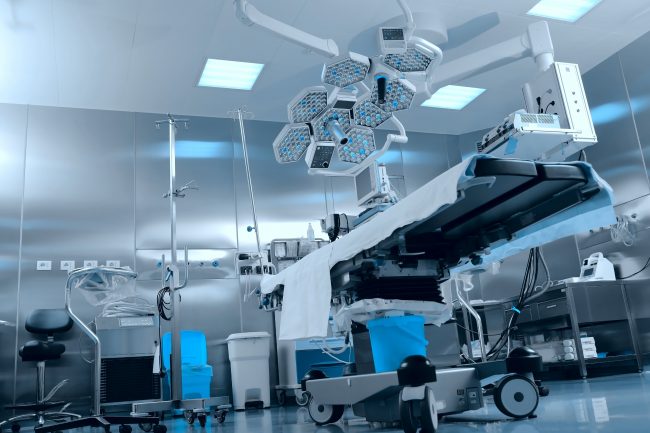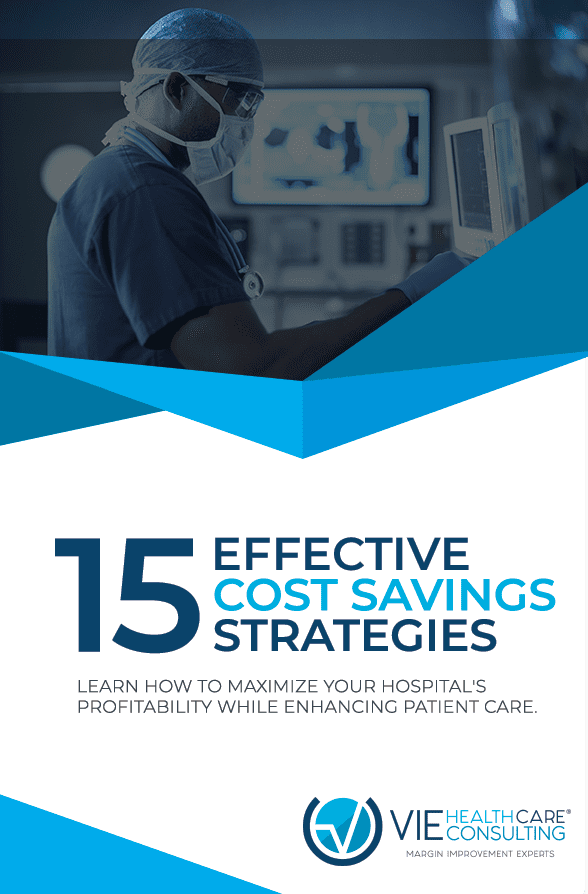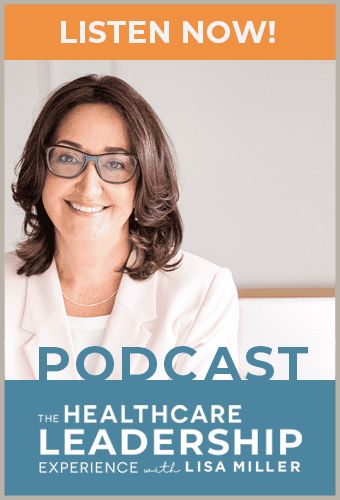The Relentless Rise of Non-Labor Hospital Costs
This article was written by Lisa Miller.
The relentless rise of non-labor hospital costs is expected to continue throughout 2019. For many healthcare executives, cost control has overtaken revenue growth as their strategic priority with a growing focus on strategies to add hospital profit margin.[1]
In our experience at VIE Healthcare Consulting, compiled from our in-depth analysis and expertise, these seven strategies will help your healthcare organization to drive margin improvement within the next 30 days.
1. Optimize Your Managed Care Carve-Outs
Access immediate 30-day margin improvement opportunities in your managed care agreements.
Contracts with managed care companies are typically complex documents which may include combinations of common payment arrangements, such as percent of charges (POC), per diems, DRG, case rate and capitation. These arrangements are often further qualified by a variety of additional special provisions, including carve-out, carve-in and stop-loss coverage.
The bottom line for hospitals is that they are now exposed to a degree of risk that once fell on the managed care companies through these contracts.
Managed care contract optimization improves net revenues by 10-25% more than contracts which simply increase all fixed rates (eg, per-diems, case rates) across the board.
Managed care contract optimization improves net revenues by 10-25% more than contracts. Click To Tweet
Managed care contract modeling also offers an opportunity to leverage significant revenue improvement for hospitals.
For example: A managed care agreement allows for an implant carve-out which states that “all implants at a charge above $8,000 will be paid” but the OR has orthopedic cases where the implant costs may not reach that threshold. In this case, your hospital will not be reimbursed for these implants.

Analyzing your managed care agreements for your surgical cases, particularly where implant costs are high, enables you to create actual models of cases and identify where your hospital is losing revenue. The good news is that most managed care agreements won’t require immediate renegotiation. They will, however, benefit from a review and analysis mapped to your cases to ensure you are maximizing every opportunity for reimbursement.
2. Charge Master Analysis
A well-maintained, well-defined Charge Master can mean the difference between millions of dollars in increased costs or added revenue.
The Charge Master is one of the single most important pieces of data that exists within your hospital.
Compared to other vital information, such as patient and clinical records, the Charge Master is unique. Here’s why:
- It can directly and profoundly affect the financial efficiency and performance of your hospital.
- The Charge Master file is the lynchpin piece of data linking all the various systems related to financial control, including purchasing, dispensing and financial billing functions.
- An efficient, up-to-date Charge Master can set the stage for a detailed analysis into what, and how, a hospital is purchasing, dispensing, and billing.
- This analysis enables informed decisions on how to save money, time, and resources at each of those three stages. Without a clean Charge Master, this is not possible.
Due to the nature of its function – tracking fluctuations in purchasing behavior and relating it to constantly updated billing practices – a Charge Master is essentially out of date as soon as it is created. Maintaining an organized and current Charge Master therefore requires a variety of maintenance tasks on an ongoing basis.
To ensure these are effective, hospitals should be aware of the three key issues that affect the financial performance of a Charge Master, namely:
- Missing charges.
- Incorrect charges.
- Incorrect data from the item master.
3. Every Day Innovation and Your Employee Ideas
Explore the untapped potential of employee ideas to improve your margins.
Innovation must form a central part of your future strategy to enable your hospital to respond with agility to an increasingly global and competitive marketplace.
Every Day Innovation occurs when every employee is actively supported and encouraged to contribute towards the generation and implementation of new ideas and innovation in your hospital. Organizations are now realizing they must commit to innovation as a key strategy for success and therefore must expect and support innovation from everyone.
Why Every Day Innovation?
Every means:
- Involving everyone in innovation.
- Cultivating a cultural shift to an innovation mindset across your hospital, present in every moment.
- Valuing every type of innovation, from small to transformational.
5 steps to implement Every Day Innovation in your hospital:
In our experience, the most successful innovation strategies define focused business challenges and ask employees for suggestions to resolve specific problems in a short time period, such as, how to reduce overtime spending and improve patient care and customer service. For optimum results we recommend the following:
- Engage your entire organization. Your employees are your most effective source of new business ideas and innovation. In addition, a ‘common ideas’ management system promotes cross-pollination, facilitates global recognition and minimizes support and training costs.
- Embrace self-organization as a key design principle. Avoid a system that relies on a single central point for evaluating or even routing ideas. It is impossible to monitor the different and evolving innovation needs of your organization from a single location.
- Start small to scale up. Avoid driving collaborative ideas management on a large scale if your senior leadership or culture isn’t ready for openness and cooperation.
- Start with passionate and “friendly” users in the organization. A ‘one-size-fits-all’ innovation system isn’t always appropriate for more mature organizations where some innovation activities already exist. Begin implementation with employees and teams where motivation and innovation are already evident.
- Focus on long-term change. A cultural change takes time and patience to implement new practices and tools successfully.
Research suggests that every day employee innovation saved companies more than $110 million dollars in time, materials, labor or energy, an average of $1,256 per suggestion[2].
4. Apply Performance Measures to Fundraising
Does net return philanthropy have the potential to be your hospital’s most valuable revenue producer?
In our experience, at least 70% of corporate assets in healthcare systems are unexpressed employee ideas and employees often want to share those ideas to be a part of the solution.
At least 70% of corporate assets in healthcare systems are unexpressed employee ideas. Click To Tweet
Industry research also suggests that healthcare organizations which focus on building a culture to encourage and recognize gratitude are:
- Delivering better patient outcomes.
- Increasing patient satisfaction.
- Reducing clinician burn-out.
- Increasing job satisfaction and engagement[3].

Tracking the performance of your philanthropy division is as vital as measuring every other aspect of your finances each month. Make it a resolution for 2019. Getting started is simple.
Say “Thank You.” Personal “thank you” calls or notes from your CEO or CFO go a long way towards building and cementing strong relationships with your donor community. Call them up to say “Thank you.” Let them know their donations are touching lives and give them examples of positive ways their gifts will be used.
Hiring a celebrity for an event can also bring in significant fundraising revenue.
5. Avoid Expense Creep
Be aware of the impact an expense creep could have on your margins.
Expense creep affects three critical areas in margin improvement.
Product creep, which typically occurs in these two ways:
- Unauthorized, higher-priced products are introduced on an unmonitored basis, frequently at list price.
- A growing utilization of higher-cost products occurs, resulting in an increased use of more expensive items.
Price creep occurs when suppliers slowly increase prices over time or subtly apply fixed discounts to new price lists.
If ignored or unidentified, both price creep and product creep can have a major impact on your hospital’s profitability. In particular, they can affect the cost of physician preference items, such as cardiac stents or cardiac rhythm devices and orthopedic implants. These items often represent up to 40 percent of a hospital’s supply budget.
Cost shifting occurs when suppliers seek to compensate for discounts by quietly increasing prices. These increases are often overlooked by purchasing departments until their aggregate spend history is retrospectively analyzed.
Close analysis of all three areas can help to drive margin improvement within 30 days.
Take back control of your hospital’s purchased services spend.
Complete our concise hospital cost assessment and let us provide a detailed evaluation of your current practices and personalized recommendations in three critical areas.
- Margin improvement strategy.
- Purchased services.
- Best practices for hospital adoption.
Take our hospital cost assessment now.
6. Negotiation Strategy Training for Your Organization
Implementing specialist coaching for employees and key staff involved in vendor negotiations is an essential strategy for driving margin improvement across your hospital.
Your supply vendors and managed care companies use sophisticated strategies and commit significant resources to educate their employees in highly skilled contract negotiation. Hospitals must learn to apply the same, or more advanced, strategies and analytics during negotiations in order to minimize risk and drive margin improvement.
Ultimately, if your results are consistently improved by 1, 2, or 3%, that is where the big impact on your bottom line will come.
For example, with a 10% margin, your organization would require $10 million in new sales to realize $1 million dollars in profit, which is only 1%. In comparison, if your margin is 5%, you would need to make $20 million in new sales to achieve 1% in profits.
Find out more about our dedicated negotiation training and coaching for hospital staff.
7. New Sources of Revenue
Tap into the hidden opportunities for non-patient revenue to drive margin improvement.
Downward pressure on patient margins requires hospitals to be increasingly creative in generating more revenue. Forward-thinking hospitals now diversify into areas such as:
- Occupational medicine and wellness services to employers.
- Providing financial auditing services.
- Generating revenue from outpatient laboratories and through joint ventures with physicians and businesses in their community.
- Partnering with manufacturers for clinical trials.
For example, Michigan based Beaumont Hospitals reap millions of dollars in non-patient revenue through such ventures as the Beaumont Commercialization Center and shared ownership in the Northwood Shopping Center at 13 Mile Road and Woodward Avenue.
Another hidden opportunity is your hospital’s “IP” (Internet Protocol) that can be licensed or sold. How can you access its unexplored non-patient revenue opportunities?
VIE Healthcare has compiled a number of best practices like these to improve your hospital’s profit margin while you continue delivering quality patient care.
Schedule your complimentary strategy session on one or more of these seven areas.
Phone: 1-888-484-3332 Ext 500 | Email: info@viehealthcare.com
[1] https://www.advisory.com/research/health-care-advisory-board/blogs/at-the-helm/2018/07/hcab-topic-poll
[2] https://www.wsj.com/articles/SB10001424052970204774604576631063939483984
[3] https://www.ahp.org/resources-and-tools/ahp-connect-articles/ahp-connect-details/ceo-corner-ethics-and-philanthropy



